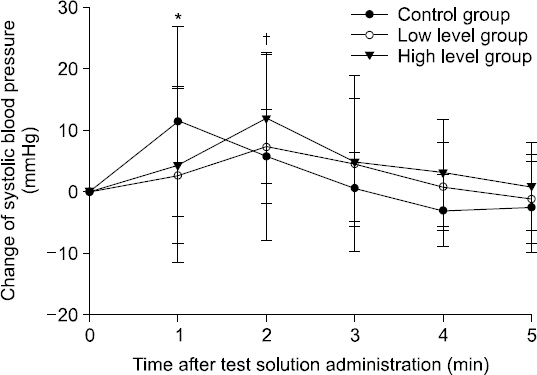Anesth Pain Med.
2016 Jul;11(3):285-290. 10.17085/apm.2016.11.3.285.
Changes of the T-wave on range of spinal blockade after low dose epinephrine administration
- Affiliations
-
- 1Department of Anesthesiology and Pain Medicine, Chonbuk National University Medical School, Jeonju, Korea. jw88lee@gmail.com
- KMID: 2344933
- DOI: http://doi.org/10.17085/apm.2016.11.3.285
Abstract
- BACKGROUND
Epidural test solution is administered to confirm the correct positioning of an epidural catheter. Hemodynamic changes after administration of epidural test solution reportedly help confirm intravenous (IV) placement of epidural catheters. The change in T wave amplitude is important for checking intravascular placement of epidural catheters. We examined changes in T wave amplitude according to the level of spinal anesthesia after IV epinephrine administration.
METHODS
Eighty-one healthy patients undergoing spinal anesthesia were randomized into three groups: group C (control), group L (low spinal block), and group H (high spinal block). All patients received an IV administration of test solution, 3 ml of 1% lidocaine and epinephrine 10 µg. Systolic blood pressure (SBP), heart rate (HR), and T wave amplitude were measured up to 5 min after test solution administration. Adverse reactions post administration of test solution were also recorded.
RESULTS
In all groups, after administration of IV test solution, SBP and HR increased, and the T wave amplitude decreased. There were no significant differences in HR, SBP, and T wave amplitude changes between the groups after administrating test solution. Fifteen out of 25 patients (60.0%), 10 out of 24 (41.6%), and 11 out of 23 (47.8%) complained of adverse symptoms in groups C, L, and H, respectively.
CONCLUSIONS
This study suggests that change in T wave amplitude after administration of a low dose of epinephrine is not affected by the spinal block range.
Keyword
MeSH Terms
Figure
Reference
-
1. Coates MB. Combined subarachnoid and epidural techniques. Anaesthesia. 1982; 37:89–90. DOI: 10.1111/j.1365-2044.1982.tb01016.x. PMID: 7081660.
Article2. Moore DC, Batra MS. The components of an effective test dose prior to epidural block. Anesthesiology. 1981; 55:693–6. DOI: 10.1097/00000542-198155060-00018.
Article3. Guinard JP, Mulroy MF, Carpenter RL. Aging reduces the reliability of epidural epinephrine test doses. Reg Anesth. 1995; 20:193–8. PMID: 7547654.4. Guinard JP, Mulroy MF, Carpenter RL, Knopes KD. Test doses: optimal epinephrine content with and without acute beta-adrenergic blockade. Anesthesiology. 1990; 73:386–92. DOI: 10.1097/00000542-199009000-00004. PMID: 1975483.5. Tanaka M, Sato M, Kimura T, Nishikawa T. The efficacy of simulated intravascular test dose in sedated patients. Anesth Analg. 2001; 93:1612–7. DOI: 10.1097/00000539-200112000-00059. PMID: 11726454.
Article6. Takahashi S, Tanaka M. Reduced efficacy of simulated epidural test doses in sevoflurane-anesthetized adults. Can J Anaesth. 1999; 46:433–8. DOI: 10.1007/BF03012942. PMID: 10349922.
Article7. Tanaka M, Goyagi T, Kimura T, Nishikawa T. The efficacy of hemodynamic and T wave criteria for detecting intravascular injection of epinephrine test doses in anesthetized adults: a dose-response study. Anesth Analg. 2000; 91:1196–202. DOI: 10.1097/00000539-200011000-00028. PMID: 11049908.
Article8. Lee JW, Kim D, Choi HH, Kim DC. The change of T-wave on electrocardiogram after epinephrine test dose in spinal anesthetized adults. Korean J Anesthesiol. 2010; 58:351–6. DOI: 10.4097/kjae.2010.58.4.351. PMID: 20508791. PMCID: PMC2876855.
Article9. Tanaka M, Nishikawa T. A comparative study of hemodynamic and T-wave criteria for detecting intravascular injection of the test dose (epinephrine) in sevoflurane-anesthetized adults. Anesth Analg. 1999; 89:32–6. DOI: 10.1097/00000539-199907000-00006. PMID: 10389774.
Article10. Nam K, Seo JH, Bahk JH. Unsuspected intravascular migration of a thoracic epidural catheter in a thoracotomy patient: A case report. Anesth Pain Med. 2013; 8:184–6.11. Tetzlaff JE, O’Hara J Jr, Yoon HJ, Schubert AG. Power spectral heart rate analysis demonstrates decreased activity of the sympathetic nervous system during low bupivacaine spinal anesthesia. J Clin Anesth. 1998; 10:133–6. DOI: 10.1016/S0952-8180(97)00253-5.12. Liu SS, Stevens RA, Vasquez J, Kao TC, Sheikh T, Aasen M, et al. The efficacy of epinephrine test doses during spinal anesthesia in volunteers: implications for combined spinal-epidural anesthesia. Anesth Analg. 1997; 84:780–3. DOI: 10.1213/00000539-199704000-00015. PMID: 9085957.13. Hanss R, Ohnesorge H, Kaufmann M, Gaupp R, Ledowski T, Steinfath M, et al. Changes in heart rate variability may reflect sympatholysis during spinal anaesthesia. Acta Anaesthesiol Scand. 2007; 51:1297–304. DOI: 10.1111/j.1399-6576.2007.01455.x. PMID: 17944631.
Article14. Liu SS. Hemodynamic responses to an epinephrine test dose in adults during epidural or combined epidural-general anesthesia. Anesth Analg. 1996; 83:97–101. DOI: 10.1097/00000539-199607000-00017. PMID: 8659773.
Article15. Tanaka M, Nishikawa T. Does the choice of electrocardiography lead affect the efficacy of the T-wave criterion for detecting intravascular injection of an epinephrine test dose? Anesth Analg. 2002; 95:1408–11. DOI: 10.1097/00000539-200211000-00056. PMID: 12401634.
Article16. Takahashi S, Tanaka M, Toyooka H. The efficacy of hemodynamic and T-wave criteria for detecting intravascular injection of epinephrine test dose in propofol-anesthetized adults. Anesth Analg. 2002; 94:717–22. DOI: 10.1097/00000539-200203000-00044. PMID: 11867404.
Article17. Albright GA. Cardiac arrest following regional anesthesia with etidocaine or bupivacaine. Anesthesiology. 1979; 51:285–7. DOI: 10.1097/00000542-197910000-00001. PMID: 484889.
Article18. Hahn RG, Löfgren A. Epinephrine, potassium and the electrocardiogram during regional anaesthesia. Eur J Anaesthesiol. 2000; 17:132–7. DOI: 10.1046/j.1365-2346.2000.00625.x. PMID: 10758458.
Article19. Atterhög JH, Eliasson K, Hjemdahl P. Sympathoadrenal and cardiovascular responses to mental stress, isometric handgrip, and cold pressor test in asymptomatic young men with primary T wave abnormalities in the electrocardiogram. Br Heart J. 1981; 46:311–9. DOI: 10.1136/hrt.46.3.311. PMID: 7295424. PMCID: PMC482650.20. Goldberger JJ, Ahmed MW, Parker MA, Kadish AH. Assessment of effects of autonomic stimulation and blockade on the signal-averaged electrocardiogram. Circulation. 1994; 89:1656–64. DOI: 10.1161/01.CIR.89.4.1656. PMID: 8149533.
Article
- Full Text Links
- Actions
-
Cited
- CITED
-
- Close
- Share
- Similar articles
-
- The change of T-wave on electrocardiogram after epinephrine test dose in spinal anesthetized adults
- Prolongation of Spinal Anesthesia with T-Cain by Epinephrine and Clonidine
- Comparison of Clinical Effect of Low Dose Bupivacaine Added with Fentanyl and Conventional Dose Bupivacaine in Spinal Anesthesia for a Transurethral Resection of the Prostate
- Effect of Intrathecal Tetracaine (T-caine) and Bupivacaine (Marcaine) on Tourniquet Pain
- The Clinical Effects of a Small-dose of Intrathecal Bupivacaine and Alfentanil for Short-duration Surgery: A Randomized Double-blinded Study




